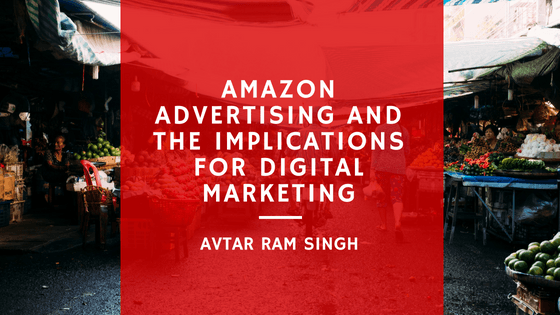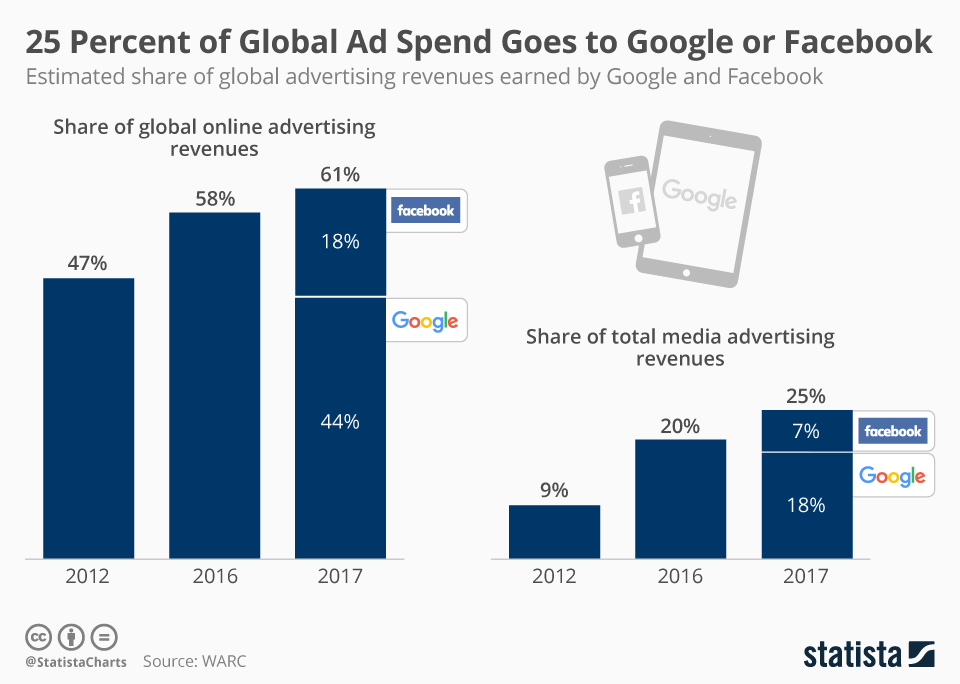
By Avtar Ram Singh, {grow} Contributing Columnist
Some interesting news broke last week. Amazon reported their Q2 2018 financial figures, reporting revenues of $52.9 billion, and a record $2.35 billion in profits.
A figure that didn’t go unnoticed, however, was a 130% QoQ (quarter-over-quarter) spike in the revenue from the “Other” segment for Amazon, which is primarily – advertising.
That 130% spike meant Amazon made $2.2 billion in advertising revenue in the second quarter of 2018.
To put that into perspective, Twitter’s advertising revenue for the entire year of 2017 was $2.1 billion.
Pretty much like the likes of Google and Facebook, Amazon has a self-serve ads platform, using which advertisers can buy one of the many types of ads (from display ads to mobile interstitials) made available by Amazon on their own and some third-party websites.
As things stand however, $2.2 billion in advertising revenue isn’t a big drop in the massive online advertising bucket that is currently dominated by, you guessed it, Google and Facebook.

As the above chart from Statista shows, Facebook and Google control a joint ~60% in online advertising revenue, and Facebook’s 18% share in 2017 equated to about $40B. Extrapolating based on those figures, it’s fairly accurate when analysts say that Amazon’s digital advertising share will probably only reach 3-4% this year.
Is Amazon going to break the Facebook and Google duopoly this year? No. Far from it.
But should marketers be increasingly interested in Amazon’s advertising offerings and try them out for their businesses? Absolutely.
Marketers Have Been Focusing on Amazon for a While
This goes without saying. The $2.2 billion is obvious enough.
Beyond the “Amazon marketing hackers” (of which many exist), that focus on trying to game Amazon’s algorithm to rank their products higher in Amazon’s search results, established advertising agencies and brands have made Amazon a key part of their marketing strategy.
Massive agencies like 360i, Mindshare and many others have Amazon-specific solutions, responding to clients that have expressed a deep desire to advertise on the platform.
In fact, some brands have been at it long enough that they’re getting hungrier. Pernod Ricard has been trying to push Amazon to expand their offering to include more options for video advertising on the platform. Amazon does offer video advertising on a few of its services, but not nearly enough.
It’s Google, not Facebook, That’s Mostly at Risk
If you talk to most marketers, they’ll tell you that they focus on two broad objectives when thinking about phases of consumer marketing. The first, is interest and awareness. This is where consumers discover products and services, and are introduced to new products or companies.
The second, is intent. This is where consumers are aware of products, and are looking for a specific one, or looking for a specific category of a product or service.
Facebook primarily operates in the first phase. Google, in the second.
The problem for Google is that Amazon operates in the second phase as well.
Facebook’s great for that top of the funnel advertising content, the videos, the explainers, the links to articles and case studies, to get people to know a little bit more about what you have to offer. Google’s always been great at being an entry point for consumers searching for “beach towels in Miami” or “buy sunglasses in Austin”.
That follows a click from Google to a company’s website, where they hope for a conversion, and if not, get their retargeting ready.
For Amazon, you open the website, search for “sunglasses” or “Rayban sunglasses” and that’s that. It doesn’t get a lot more direct than that, a behaviour extremely similar to Google.
One Platform, One Click, One Tracking Technology
One of the biggest complaints advertisers have on digital spend, is tracking, fraud and attribution. Different estimates are thrown around, but according to Juniper Research, the advertising fraud figure in 2018 will likely hit $19 billion.
Couple that with how Facebook’s data almost never seems to correlate with what you see on Google Analytics, and marketers are always trying to justify the discrepancies, of which there are many.
Amazon’s unique advantage is that it sits at the intersection of media and commerce, where search, conversion and attribution all take place on a single platform. Some might say that’s not a good thing, but at least that leaves out any room for data discrepancy. Amazon does however, seem to have an exhaustive list of third-party ad-servers and technology providers for their advertising business.
Amazon Isn’t All Conquering, Though
Despite what many would have you believe, while Amazon is dominant in certain spaces and areas, advertising isn’t one of them, and it will probably never overtake Facebook and Google in advertising market share. One of the primary reasons for this, is geography.
Amazon may ship to a number of countries, but it doesn’t have operations in all of them. As a result of this, advertisers in specific markets will focus on the local equivalents, such as Lazada in South-East Asia, Rakuten in Japan and the ever-expanding Alibaba and JD.com in China (and beyond).
In addition to that, those operating in the B2B space like enterprise software, law firms, architecture companies and so on, will always focus an element on online advertising (mostly on Google, a fair bit on LinkedIn, and a little bit on Facebook) with a bigger element on offline advertising.
In Conclusion
Amazon isn’t taking over the online advertising business today. And it likely won’t take over the online advertising business in the next 4-5 years, either.
It is however, playing an increasingly important role in the lives of consumers, and companies that operate within specific verticals and in the e-commerce space. For those companies, ignoring Amazon’s advertising potential and the potential impact it can have on their business would be short-sighted.
Amazon’s latest figures are an indicator that more companies are putting their advertising dollars at work on the platform, and based on the increasing trend, and the responses from the advertisers that have experimented with the platform, it’s cementing its place in their approach to marketing for the future.
 Avtar Ram Singh is the Head of Strategy at FALCON Agency, a performance-led, business results oriented marketing agency that operates in South East Asia. He’s built marketing strategies and performance frameworks for brands on global and regional levels, across a variety of industries. You can find him on LinkedIn, and Twitter.
Avtar Ram Singh is the Head of Strategy at FALCON Agency, a performance-led, business results oriented marketing agency that operates in South East Asia. He’s built marketing strategies and performance frameworks for brands on global and regional levels, across a variety of industries. You can find him on LinkedIn, and Twitter.


